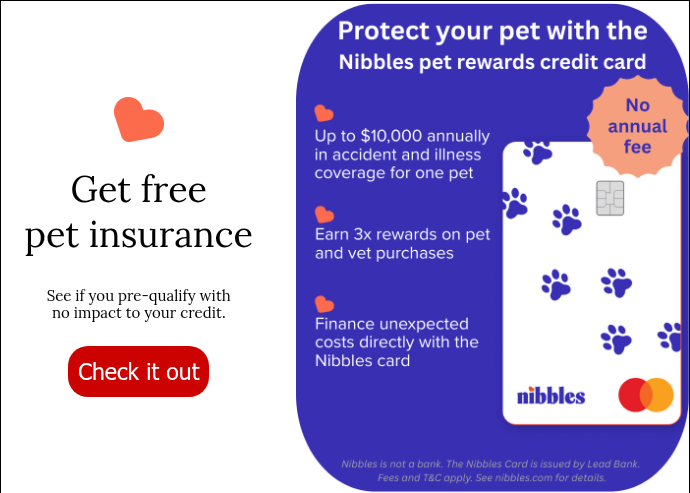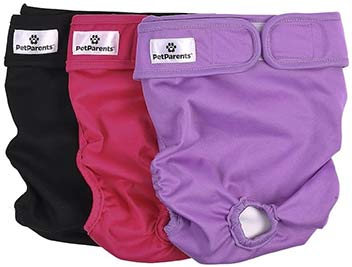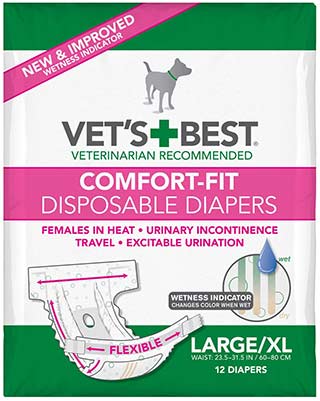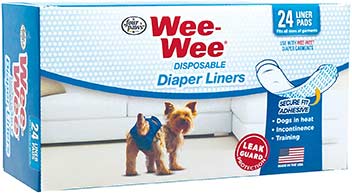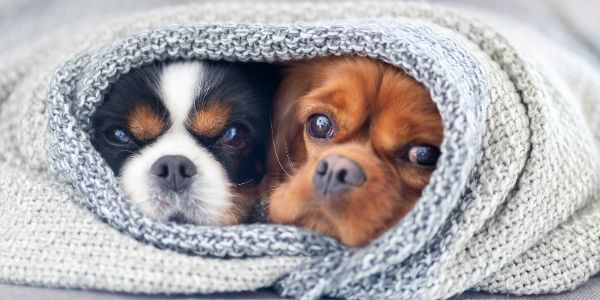 Sometimes, dog owners decide to wait to spay or neuter their dog for a variety of reasons.
Sometimes, dog owners decide to wait to spay or neuter their dog for a variety of reasons.
Even for dog owners who were planning on having their dog spayed or neutered sooner rather than later, the coronavirus pandemic may have thrown a wrench in those plans.
Many veterinarians had to postpone elective surgeries such as spays and neuters to save equipment, supplies, and minimize interactions.
No matter the reason, it's important to know what kind of behavior changes you might see as your dog hits sexual maturity. Especially if you have a female dog going into heat, you'll want to prepare for what that means and have supplies on hand to make your (and her) life easier.
Read on for our tips on how to know if your dog is going into heat and what you should do.
What Does "In Heat" Mean?
How Long Is a Dog's Heat Cycle?
How Often Does a Dog Go Into Heat?
When Does a Dog's First Heat Happen?
How Does Behavior Change In Heat?
What to Do When Your Dog Is in Heat
Challenges of Owning an Intact Dog
Wondering when you should spay or neuter your dog? Watch Preventive Vet's Yappy Hour, featuring Dr. Beth Turner, to learn more about spay and neuter timing and how it affects your dog's health and behavior:
When Should You Spay or Neuter Your Dog?
If you're not sure when you should spay or neuter your dog, consult with your veterinarian to evaluate when would be best for your dog's health, lifestyle, and situation.For more information about the pros and cons of waiting, check out our article about when to get your dog fixed.
The American Veterinary Medical Association states it well: "For canine patients, due to the varied incidence and severity of disease processes, there is no single recommendation that would be appropriate for all dogs.
Developing recommendations for an informed case-by-case assessment requires an evaluation of the risks and benefits of spay/neuter, including its potential effects on neoplasia, orthopedic disease, reproductive disease, behavior, longevity, and population management.
However, many factors other than neuter status play an important role in these outcomes, including breed, sex, genetics, lifestyle, and body condition." Source: AVMA
What Does 'Going Into Heat' Mean?
When an unspayed female dog goes into heat, it means she is physically capable and receptive to mating. She'll be releasing hormones that other dogs can smell that communicate she is open to conceiving puppies.
There are four stages of a dog's reproductive cycle:
- Proestrus: During this stage, your dog's body is preparing for estrus. You'll see swelling of the vulva and the start of bloody discharge.
- Estrus: This phase is when your dog, if she is fertile, is able to become pregnant, as the ovaries begin to release eggs for fertilization. Discharge during this time tends to become lighter in color and the dog becomes more flirtatious.
- Diestrus: Your dog's body is recovering from the estrus phase and is no longer fertile. You'll see less flirtatious behavior, reduction of any swelling, and discontinuation of vaginal discharge.
- Anestrus: The anestrus phase is your dog's reproductive cycle's time of rest and lasts until their next cycle begins.
You'll see most behavioral changes during the proestrus and estrus phases of the reproductive cycle.
Important Note: After estrus, a serious medical complication called pyometra can occur. Pyometra is an infection of the uterus. Signs include pus-like discharge from the vulva. Because this condition can be life-threatening, your dog should be taken to the veterinarian immediately.
Questions? To chat with a veterinarian about whether your dog's behavior during their heat cycle is normal, Click here
How Long Does a Dog's Heat Cycle Last?
A dog's heat cycle usually lasts between three to four weeks. The estrus phase, when she can become pregnant, typically lasts for one to two weeks of the full cycle.
How Often Do Dogs Go Into Heat?
Dogs that aren't spayed go into heat about every six months. Younger and older dogs tend to have a more irregular heat cycle, and often, the size of your dog can affect how often they go into heat. Smaller breeds also might have more than two cycles a year, and larger breeds might have just one a year.
When Do Dogs Go Into Heat For The First Time?
The first heat cycle usually happens between the age of six to sixteen months old — but this can vary greatly depending on your dog's breed. Toy breeds have had their first heat as young as four months old, and some giant breeds don't go into season until closer to two years.
PRO TIP: Ask your breeder when their dogs typically went into heat for the first time, as they can give you an idea of when they usually see females in their breeding lines have their first cycle.
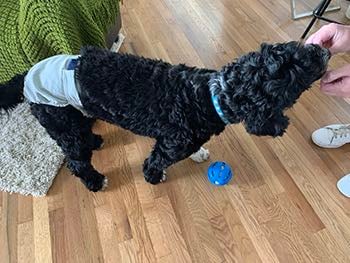
Clover's First Heat Experience
Preventive Vet office pup, Clover the Portuguese Water Dog, went through her first heat cycle before being spayed. She was almost 11 months old when her owners noticed the first visible signs of heat — a few drops of bloody discharge on the floor where she'd been sitting.
Prior to the physical signs of heat, Clover's owners had also noticed she'd become more intense in her interactions with other females at the dog park, but didn't show the same kind of attitude with the males she encountered.
Once they saw signs of estrus, she stayed home and away from the park. Clover acted a tad more restless than usual, panting a lot and always moving from resting spot to resting spot. Luckily, she had lots of team members in the office to give her pets whenever she asked for them.
For the first five days of her active heat cycle, her heat pants needed to be changed 4 or more times a day, but then slowed to only needing twice daily changes.
By using disposable pads inside her heat pants, they were able to cut down on how often they needed to launder the cloth diaper. Once her cycle was finished, Clover was spayed when she was 14 months old.
PRO TIP: Before she went in for her spay surgery, she had practice getting used to the "cone of shame." By taking some time before your dog's spay surgery to desensitize them to wearing a cone, you can make the experience much less stressful.
Watch this video below of Clover practicing having the cone put on and walking around while wearing it:
Introducing Your Dog to the Cone
How Will Your Dog's Behavior Change When They're In Heat?
Your dog might start to act differently during proestrus and estrus. Some dogs have more obvious behavioral changes than others — it can be different for each individual dog. In some cases of a dog's first heat cycle, they can also experience what's called a "silent heat." This is where there are little to no physical signs of being in heat and very subtle behavioral changes.
Many owners don't notice the more subtle changes in behavior as their dog gets closer to going into heat, only to realize what's happening when they see bloody discharge during the latter part of the proestrus phase and the estrus phase.
Here are some behavioral changes you might notice when your dog is going into heat:
- Change in Appetite: Your dog might be suddenly ravenous or become more picky in their eating habits.
- Restless Behavior: You might notice that your dog seems to be on edge, pacing more than usual, or panting excessively.
- Lethargic Behavior: Some dogs become less energetic as they go into heat. If your dog seems unusually tired, or not as interested in playing with you, it could be a sign they are beginning their heat cycle.
- More Irritable or "Cranky" With Other Dogs: As their hormone levels change, you might see your dog become less tolerant of other dogs in your home. During the first phase of the heat cycle, female dogs are not receptive to mating and might act more aggressively than usual in telling other dogs to give them space.
You might see aggressive behaviors towards both female and male dogs during proestrus, but as your dog moves into her estrus phase, you'll see her act more "flirty" with males. - Flirtatious Behavior: Once a dog enters the estrus phase of her cycle, she is receptive to the attention of male dogs and might seek it out. She might start to present her rear and flag her tail to one side when around male dogs as an invitation.
- Desire to Escape and Seek a Mate: When a dog goes into estrus, she will want to follow her instincts in seeking out a male to mate with. This means she might try to escape your home or yard to check out what options are nearby.
- Increased Urination: If your dog is starting to urinate more frequently and in smaller amounts, this could be a sign she's "marking" as she goes into heat. This is the easiest way to spread the message to other dogs that she's going into season.
- Increased Self Grooming: Your dog might be licking her genital area more to clean up any discharge.
Important note: The above signs can also be associated with medical problems unrelated to a heat cycle. If physical signs of heat, primarily swelling of the vulva and discharge, are not present and the condition persists, it is recommended that you have your dog examined by a veterinarian.
Questions? To chat with a veterinarian about whether your dog's behavior during their heat cycle is normal, Click here
What You Can Do When Your Dog Is In Heat
Have Sanitary Supplies Ready
When your dog begins to have discharge during her proestrus and estrus phases, having wearable "heat pants" or diaper can help keep your home clean. Every dog's flow is different and is often heavier and more bloody in the beginning.
As estrus progresses, it tends to become lighter in color, either clear or brownish. You can purchase disposable diapers or invest in a washable cloth diaper to use with disposable liners.
For safety's sake, you want to monitor your dog whenever they're wearing heat pants or diapers as they do present a high risk of intestinal blockage if ingested (they are highly absorbent and will expand in the stomach).
PRO TIP: You can place a disposable dog maxi pad inside of the diaper during heavier flow to reduce the frequency of laundering the cloth diaper. Some heat pants aren't absorbent, so check to see if you need to purchase insertable pads for the one you use.
When your dog isn't wearing a diaper or as their flow lessens, putting down absorbent pads in your dog's normal resting areas (such as their crate) can help contain any messes.
This is not recommended if your dog will chew on or ingest these pads, as they can also cause intestinal blockages. Using double-sided tape to adhere a pad to the bottom of their crate can help keep it from slipping around.
Use dog-formulated cleansing wipes to keep your dog's sensitive areas clean. This is especially important to do whenever you change their diaper to prevent skin irritation and fur matting.
Set Up a Comfortable Environment
Create a safe space for your dog to rest. With all the hormonal changes she'll be feeling, she might want to seek out a quiet place away from the hustle and bustle. You can make this area comfortable by including a cooling mat, which can be especially useful for thick or long-coated dogs.
Plugging in an Adaptil diffuser may comfort your dog by exposing her to a synthetic version of the same pheromone that lactating dogs release to their puppies. Have plenty of interactive dog toys and chews for your dog to provide decompression activities.
Read our article "How to Set Up a Safe Space for Your Dog" for more tips on how to create a relaxation zone.
Accompany and Supervise Your Dog in Your Fenced Yard
You'd be surprised at the lengths male dogs will go to gain access to a female in heat. Climbing over or digging under a fence is worth the effort for them as they follow their instincts to mate.
Accompany your dog while she's outside in your fenced yard to make sure there are no unwanted visitors. Female dogs can also feel the need to wander in search of a mate, so you want to make sure they don't decide to go on an adventure.
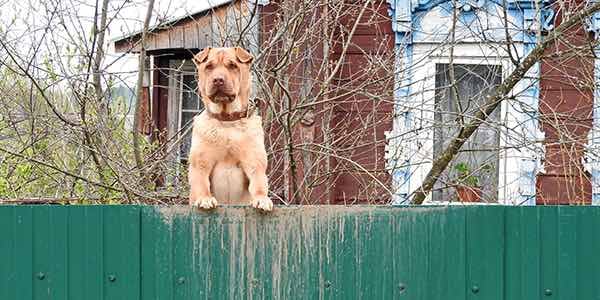
Ensure Your Dog's Microchip Is Registered & Updated
In case your dog does find their way out of your home as they follow their instincts to mate, make sure they are microchipped and the contact information on their microchip is up-to-date.
In addition, an ID tag with your contact information attached to her collar will make it easy for your neighbors to return your girl if she is out galavanting with the boys. This can help anyone who might find your dog get in touch with you as quickly as possible.
Read about how to update your dog's microchip in our article "Your Pet's Microchip: Is It Registered and Up-To-Date? Here's How to Do Both."
Avoid Interactions With Other Dogs
When your dog is in heat, don't allow her to interact with other dogs, even while on leashed walks. You most certainly want to avoid visits to the dog park as well to prevent scuffles that might arise as dogs compete for attention, accidental mating, and unplanned pregnancy. Read more about why dog park visits are best avoided further below.
Manage Dog-Dog Interactions in Your Home
If you have a multi-dog household, you might notice a shift in dynamics between your dogs. Your female dog in heat might be on the grumpy side and overreact when approached by a dog housemate.
In other cases, they might pester other dogs in the house if they feel restless. Supervise interactions between your dogs to make sure that they are being respectful of each other. Use baby gates to provide separate safe areas for each of them.
If you have an intact male in the home, they should always be kept separate from a female in heat to prevent mating. Even when kept separate, your intact male will become stressed as they can still smell a female in season and might go to great lengths in efforts to get to her.
Even if your male dog is neutered, he might still pester your female dog — supervise and separate as needed.
Consider Boarding at Your Breeder
Ask your breeder if they are able and willing to board your female during her proestrus and estrus phases. This is especially helpful if you have an intact male dog in your home.
Breeders often have the right setup and know-how to manage dog-dog interactions that involve dogs in heat and can make sure your dog doesn't have an unwanted mating.
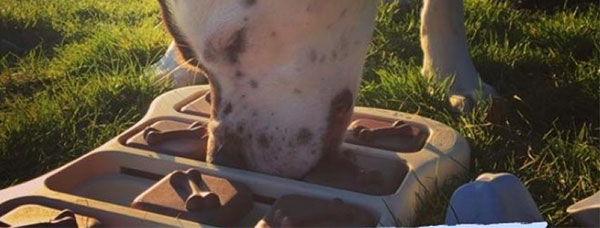
Provide Lots of Enrichment
Giving your dog lots of outlets for her pent-up energy will go a long way in easing restless behavior. Enrichment activities like puzzle toys can burn off excess energy in appropriate ways and decrease clingy behavior.
Decompression activities, like working on a Licking Mat, are excellent for reducing stress and anxiety your dog might experience during heat.
Check out our article "Dog Enrichment: Toys, Games, and DIY Ideas" to see all the ways you can easily set up enrichment for your female dog in heat.
Challenges of Having an Intact Dog (Male or Female)
Dog Boarding Requirements
Some dog boarding facilities or pet sitters are unable to board intact dogs due to the close proximity of other dogs in their care. The scent of a female dog approaching her cycle or in estrus causes intense reactions from nearby dogs and can cause a lot of stress.
Speak with any prospective boarders or pet sitters about their policies and how they manage boarding intact dogs. If you're having trouble finding a boarding facility or pet sitter who can safely care for an intact dog, contact your breeder to see if they are able to care for your dog while you're out of town.
Dog Daycare Attendance
Most dog daycares require dogs over six months old to be spayed or neutered in order to attend. This is done to ensure a safer environment for all dogs in their playgroups. A mature, intact male can elicit potentially dangerous attention from neutered males due to the difference in scent.
Mature intact males might also be practicing behaviors such as humping that could cause a dog fight. The scent of a female dog approaching her heat cycle can trigger humping and excessive attention from other dogs, intact or fixed, which can cause scuffles to break out — especially as other male dogs in the group compete for her attention.
Speak with prospective dog daycares about their requirements for spaying and neutering. Many will allow attendance from puppyhood until six months of age, which provides plenty of much-needed puppy socialization.
Don't be surprised, however, if they do ask you to refrain from bringing your dog to daycare until after they are fixed, even before the six-month mark. Some dogs begin to show behavior that indicates they are approaching sexual maturity faster than others, and you don't want your dog to be hurt or create tension within the daycare group.
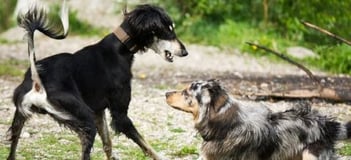
Dog Park Interactions
If you have an intact dog, taking your dog to the dog park to play comes with different risks and more responsibility for you to manage play and interactions.
Intact dogs are not bad dogs by any means, but their scent and hormones can change the dynamics within a group of dogs.
Neutered males can smell the difference and might view an intact male as a threat, which can lead to dog fights. Intact males also might tend to mark their territory more frequently or practice humping behavior during play, which often puts them at odds with other dogs.
Female dogs approaching their heat cycle are putting off all kinds of delicious smells, and both neutered and intact dogs at a dog park will be paying her more attention. This can cause her undue stress as she seeks to avoid attention from other dogs.
It might also trigger a fight between other dogs as they compete for her attention. It's never a good idea to take your intact female dog to a dog park, as it could result in a dog fight or, on the flip side, an unwanted pregnancy.
By learning what the signs of going into heat are, knowing what to expect, and having needed supplies on hand, your dog's first heat will be easier for you and your dog. And don't hesitate to ask your veterinarian for advice or if you have questions about what is normal during a dog's heat cycle.
Questions about what to expect during your dog's first heat cycle? Ask us in the comments below!


